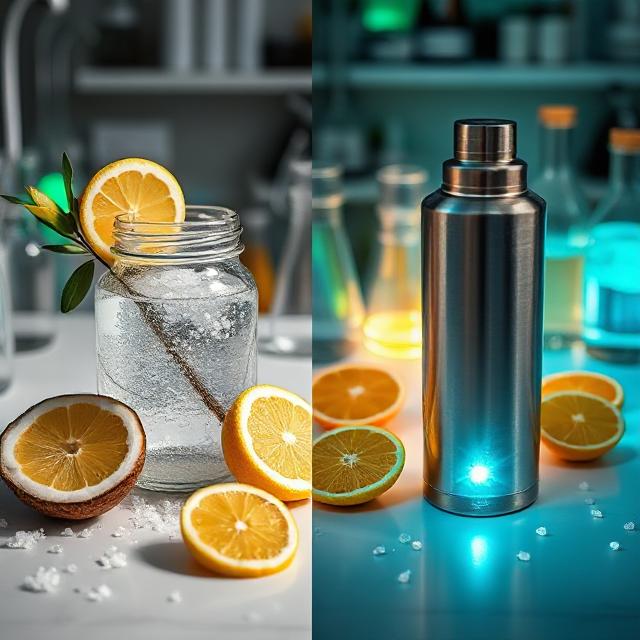
Table of Contents
DIY Electrolyte Drink vs Store-Bought: Truth Tested
In a market saturated with hydration drinks, powders, and flashy marketing claims, many health-conscious individuals are turning to a simpler, cleaner approach: the DIY electrolyte drink.
But is homemade hydration really better than store-bought options? Or are those shiny bottles actually offering something worth the price tag?
This article breaks down the science, absorption, and neurocognitive impact of DIY electrolyte drinks versus commercial formulas—so you can choose what actually supports your mental clarity, energy, and electrolyte balance.
💧 Why Electrolyte Balance Matters More Than You Think
Electrolytes—primarily sodium, potassium, magnesium, and chloride—regulate:
- Fluid balance across cell membranes
- Neuronal firing and synaptic transmission
- Muscle contractions (including the heart)
- Nutrient transport and mitochondrial efficiency
Without them, your body can’t use water properly, and your brain won’t fire efficiently. True hydration is mineral-driven, not just liquid intake.
🧪 What’s in a DIY Electrolyte Drink?
DIY electrolyte drinks typically use kitchen basics and aim to replicate the balance of isotonic hydration. Common ingredients include:
- Sea salt or Himalayan salt (sodium + trace minerals)
- Coconut water (potassium)
- Citrus juice (vitamin C + flavor)
- Magnesium citrate or glycinate powder (optional)
- Honey or maple syrup (glucose for transport)
Example Recipe:
- 16–20 oz filtered water
- 1/4 tsp sea salt
- 1–2 tsp lemon or lime juice
- 1/2 tsp raw honey (optional)
- Optional: 100–200 mg magnesium supplement
This combination replenishes lost minerals and supports cognitive clarity and mood stability, especially during fasting, workouts, or high-stress periods.
🛒 What’s in Store-Bought Electrolyte Drinks?
Commercial options range from sugary sports drinks to premium nootropic hydration blends. Let’s break them down:
🚫 Standard Sports Drinks:
- High fructose corn syrup or cane sugar
- Artificial colors and flavors
- Low in magnesium and potassium
- Acidic and often low pH (damaging to enamel and gut lining)
✅ Premium Electrolyte Mixes:
- Proper sodium/potassium ratios
- Buffered magnesium (citrate, glycinate, or malate)
- Zero sugar or stevia-sweetened
- Often include zinc, calcium, or B-vitamins
Some even include adaptogens or amino acids to support endurance and stress regulation.
Not all store-bought is bad—but the label tells the truth.
🧠 Cognitive Impact: DIY vs Store-Bought
| Factor | DIY Electrolyte Drink | Store-Bought Mix (Premium) |
|---|---|---|
| Sodium | Customizable (sea salt-based) | Precisely dosed, often optimal |
| Potassium | From coconut water or salt subs | Often included in ideal ratios |
| Magnesium | Needs to be added manually | Included (higher absorption forms) |
| Trace minerals | Present in unrefined salts | Often included intentionally |
| Sweeteners | Honey, fruit juice (optional) | Stevia, monk fruit, or clean carbs |
| Additives / Preservatives | None | Depends on brand |
| Cost per serving | ~$0.25–$0.50 | $1–$2+ |
| Brain performance benefit | Solid if balanced | Higher if includes neuro-minerals |
⚖️ Pros and Cons of DIY Electrolyte Drinks
✅ Pros
- Ultra customizable to your own needs
- No additives, dyes, or sweeteners unless chosen
- Inexpensive and sustainable
- Can be adjusted for fasting or keto
❌ Cons
- Requires time, sourcing, and measuring
- May lack precise magnesium or potassium
- Doesn’t travel well without refrigeration
- Inconsistent if not carefully formulated
⚖️ Pros and Cons of Store-Bought Electrolytes
✅ Pros
- Precisely measured mineral doses
- Convenient and shelf-stable
- Often includes performance enhancers (e.g., taurine, creatine, adaptogens)
- Ideal for athletes, travelers, or high-stress jobs
❌ Cons
- Expensive over time
- May contain synthetic additives or low-quality minerals
- Sweeteners (even “natural” ones) may disrupt gut for sensitive users
🧬 Which Is Best for Brain Performance?
If your goal is cognitive performance, mental clarity, and neurohydration, then:
- A DIY electrolyte with added magnesium and some glucose (honey, fruit juice) works great for light workouts, fasting, and desk work.
- A premium store-bought blend may be superior during peak stress, heavy sweating, or extended physical output, especially if it includes magnesium glycinate or malate.
Remember: your brain relies on a precise electrochemical environment. DIY works if you’re consistent. Store-bought works if you’re discerning.
🧪 Testing Tip: Track Your Cognitive Output
Use a self-tracking protocol for 3–5 days each:
- Compare mental clarity, focus span, and mood on days you use a DIY vs store-bought option.
- Check for signs of overhydration (frequent urination, fatigue) or underhydration (dry lips, sluggishness).
Use tools like:
- Cognitive reaction time apps
- Mood and focus journaling
- Heart rate variability (HRV) or electrolyte-sensitive smart devices
✅ Conclusion: DIY or Buy Smart
You don’t need to choose one forever. Many high performers use both:
- DIY electrolytes for daily baseline hydration
- Premium store-bought formulas for workouts, heat, or brain-intensive days
What matters most is mineral balance—not brand loyalty.
